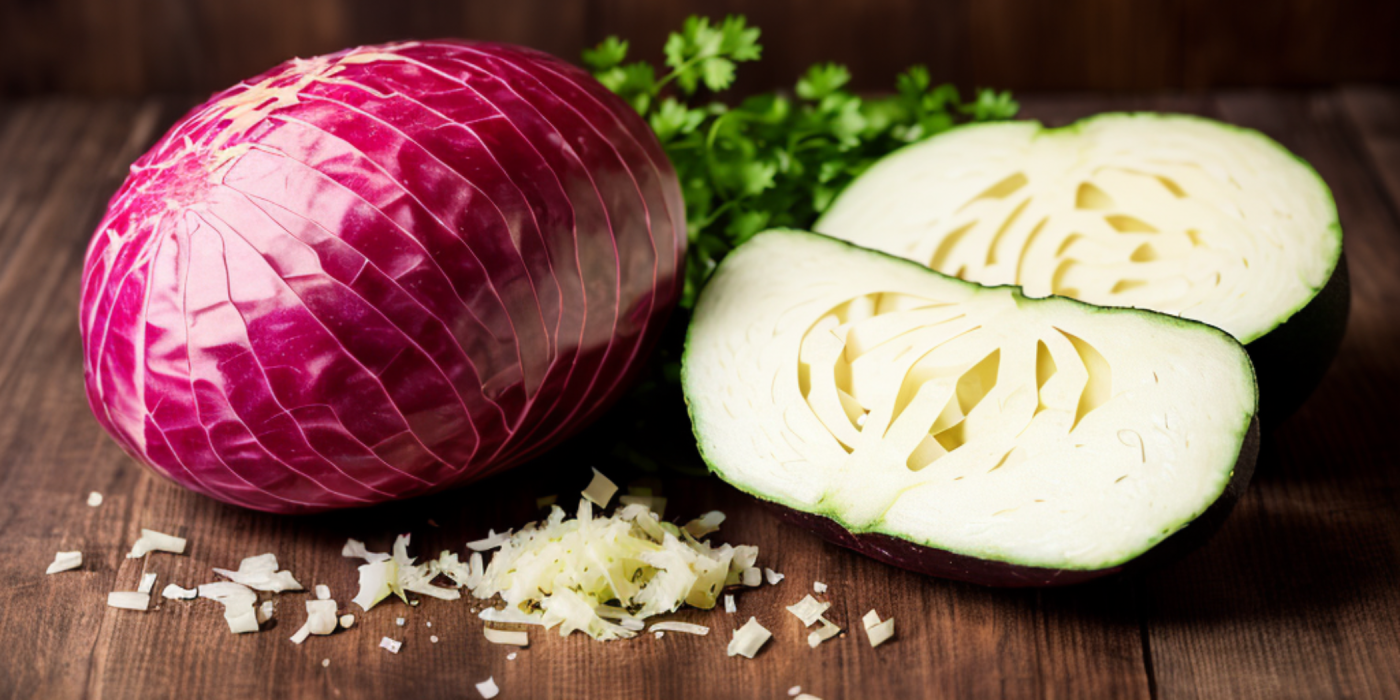Unlocking Sauerkraut: A Comprehensive Guide to Its Nutrition, Health Benefits, and DIY Recipe

In many parts of the world, sauerkraut is a familiar sight on dining tables, known for its tangy taste and distinctive crunch. What many may not know is that this simple fermented dish, commonly associated with Central European cuisine, is also a treasure trove of nutrition and health benefits. From supporting gut health to potentially reducing inflammation, sauerkraut offers an impressive array of advantages to those who make it a regular part of their diet.
Unlocking Sauerkraut
In this comprehensive guide, we'll delve deep into the world of sauerkraut. You'll discover what sauerkraut is, trace its journey through history, and explore the cultural significance of this popular fermented dish. We'll unmask the nutritional secrets behind its simple ingredients and learn why sauerkraut is revered as a powerful probiotic food.
This article will also shed light on the various health benefits sauerkraut offers. We'll touch upon how its regular consumption can influence our overall health and wellbeing, discussing its potential impacts on digestion, immune function, inflammation, and more.
In addition, you'll find practical information about the recommended daily intake of sauerkraut, along with helpful suggestions for integrating it into a balanced diet. And for the culinary enthusiasts among us, we'll even share a step-by-step guide to creating your own homemade sauerkraut.
Lastly, we'll answer some frequently asked questions about sauerkraut, ensuring that by the end of the article, you'll be fully equipped to make the most of this nutritious, probiotic-rich food. So, let's begin our sauerkraut journey!
Understanding Sauerkraut
In essence, sauerkraut is finely shredded cabbage that has been fermented by various lactic acid bacteria. This fermentation process imbues sauerkraut with its distinctive sour flavour, tender texture, and numerous health benefits.
The word 'sauerkraut' itself hails from German and directly translates to 'sour cabbage', which aptly encapsulates its culinary essence. Though the Germans are often associated with sauerkraut, its roots extend far beyond Germany.
Historical Significance of Sauerkraut
Fermenting cabbage into sauerkraut is believed to have originated in China over 2,000 years ago. During the construction of the Great Wall, workers used fermented cabbage as a sustenance source because it could be stored for long periods without refrigeration, ensuring a constant food supply during the harsh winters.
The concept of fermenting cabbage eventually found its way to Europe, where it was embraced with open arms. The Germans, in particular, honed this technique and were instrumental in popularising sauerkraut in the Western world. Consequently, sauerkraut became deeply entwined with German culinary culture, often served alongside traditional dishes such as sausages and meats.
However, sauerkraut's influence extends far beyond Asia and Europe. Due to its long shelf life and high vitamin C content, it became a valuable commodity for seafarers, including the explorers of the Age of Discovery, as it helped prevent scurvy during long sea voyages.
Thus, sauerkraut is more than just a side dish; it carries with it a rich tapestry of history and cultural significance that crosses continents and millennia.
Nutritional Content of Sauerkraut
The health benefits of sauerkraut come from its rich array of nutrients, from essential macronutrients to an impressive collection of vitamins and minerals.
Macronutrients in Sauerkraut
The base ingredient of sauerkraut, cabbage, is low in calories but rich in dietary fibre. There are approximately 4 grams of carbohydrates in a serving (100 grams) of sauerkraut, most of which come from fibre. This makes sauerkraut an excellent choice for those looking to add bulk to their diet without a significant calorie contribution.
Vitamins in Sauerkraut
Sauerkraut is a great source of vitamin C, which is essential for immune function and skin health. A 100-gram serving can provide about 20% of the recommended daily intake. Additionally, sauerkraut also contains vitamin K, vital for blood clotting and bone health.
Minerals in Sauerkraut
Sauerkraut also houses a range of essential minerals, including iron, which is essential for the formation of red blood cells; calcium, necessary for bone health and muscle function; and potassium, which aids in fluid balance and nerve transmission.
Probiotics and Enzymes in Sauerkraut
The fermentation process used to create sauerkraut promotes the growth of beneficial bacteria, known as probiotics. These microorganisms support gut health, enhance the immune system, and may even contribute to improved mood and mental health. Additionally, enzymes present in sauerkraut aid digestion, making it easier for your body to extract and utilise the nutrients in your food.
Health Benefits of Sauerkraut
Incorporating sauerkraut into your diet offers numerous potential health benefits. Let's explore these advantages, from bolstering your digestive system to contributing to a balanced diet.
Potential for Improved Digestive Health
One of the primary benefits of sauerkraut is its potential to support and enhance digestive health. Being a fermented food, it's rich in probiotics, which are beneficial bacteria that contribute to a healthy gut microbiome. Regular consumption of probiotics can assist in promoting better digestion and can even help alleviate symptoms of conditions like Irritable Bowel Syndrome (IBS) and Inflammatory Bowel Disease (IBD).
Immune System Support
Sauerkraut also plays a significant role in supporting the immune system. A large portion of our immune system is actually located in our gut, and maintaining a healthy gut flora, in part through consuming probiotic-rich foods like sauerkraut, can strengthen our overall immune response. Additionally, sauerkraut is high in vitamin C, which further aids in immune support.
Potential for Reducing Inflammation
The probiotics in sauerkraut can help reduce inflammation in the gut, which can be beneficial for overall health. Chronic inflammation has been linked to a variety of health issues, and a diet rich in anti-inflammatory foods can contribute to the prevention and management of these conditions.
Contribution to a Balanced Diet
Finally, sauerkraut is a low-calorie food with a high fibre content, which makes it an excellent addition to a balanced diet. It provides essential vitamins and minerals, contributes to satiety, and can support weight management efforts.
Recommended Daily Amount of Sauerkraut
Understanding how much sauerkraut to incorporate into your daily diet is crucial for reaping its health benefits without overdoing it. Although sauerkraut is healthy, its high sodium content makes portion control important.
Recommended Intake for Adults
Adults can typically consume about a quarter to a half cup of sauerkraut per day. This is a rough estimate, and individual needs may vary based on factors such as age, sex, overall health status, and level of physical activity. It's always wise to consult a healthcare professional or a registered dietitian for personalised advice.
Recommended Intake for Children
For children, the intake should be significantly smaller. Starting with a tablespoon or two and gradually increasing the amount (if well tolerated) is generally advised. As with adults, it's important to consider a child's overall diet and health status, and consulting a paediatrician or dietitian is recommended.
Incorporating Sauerkraut Into Your Diet
Sauerkraut can be quite versatile in your culinary repertoire. Here are a few ways to incorporate it into your meals:
- Salads: Toss a few tablespoons of sauerkraut into your salads for an added crunch and tangy flavour.
- Sandwiches: Sauerkraut makes a great addition to sandwiches and burgers, lending them a tangy contrast.
- Sides: Use sauerkraut as a side dish to complement main courses like sausages or roast meats.
- Stews and Soups: Add some sauerkraut to your stews and soups for an extra layer of flavour.
Remember, while it's beneficial to include sauerkraut in your diet, it's equally important to maintain a varied and balanced diet for overall health.
How to Make Sauerkraut at Home
Making your own sauerkraut at home can be an incredibly rewarding experience. Not only do you get to enjoy the tangy, fermented goodness of this traditional dish, but you also have full control over the ingredients used, ensuring a healthy and organic result.
Step-by-step Guide to Preparing Sauerkraut
Let's look at the basic steps involved in creating homemade sauerkraut:
Ingredients: 1 large head of cabbage 1-2 tablespoons of sea salt
Instructions:
-
Preparation: Start by removing the outer leaves of the cabbage and setting them aside. Then, cut the cabbage into quarters, remove the core, and thinly slice the rest.
-
Salting: Place the shredded cabbage in a large bowl, add the sea salt, and thoroughly mix them together. Let the cabbage sit for 30 minutes to allow the salt to draw out the juices.
-
Packaging: Once the cabbage has released its juices, pack it tightly into a clean, sterilised jar, pressing down firmly so the cabbage is submerged in its brine. Place one of the reserved outer leaves on top to help keep the cabbage submerged.
-
Fermenting: Seal the jar loosely, allowing gases to escape, and let it sit at room temperature for at least 1-2 weeks, checking periodically to ensure the cabbage remains submerged.
Tips for Storing and Using Homemade Sauerkraut
After the fermentation period, tightly seal the jar and store your sauerkraut in the refrigerator. Properly stored, it should keep for several months. Remember, homemade sauerkraut is a living food and its flavours will continue to develop over time. Enjoy it as a tangy side dish, on sandwiches, or even straight from the jar!
In Conclusion
Sauerkraut, with its humble origins and unique tangy taste, is not just a staple of Eastern European and German cuisine; it's also a nutritional powerhouse that offers various health benefits. This fermented cabbage dish is loaded with essential nutrients, including proteins, carbohydrates, and fibre. Furthermore, it is rich in vitamins, particularly vitamin C, known for its immunity-boosting properties, and vitamin K, crucial for healthy blood clotting.
In terms of mineral content, sauerkraut does not disappoint. It contains iron, essential for haemoglobin production and transporting oxygen around the body; calcium, important for bone health; and potassium, which supports nerve function and muscle contractions. Let's not overlook the probiotics that fermented foods like sauerkraut are famous for. These beneficial bacteria are an excellent aid for your gut health, potentially improving digestion and reducing inflammation.
The health benefits of incorporating sauerkraut into your diet are numerous. From potentially improving your digestive health, enhancing your immune system, and even aiding in reducing inflammation, it is a worthy addition to any balanced diet.
Making sauerkraut at home is also a rather straightforward process. Our recipe guide provides you with an easy step-by-step method to prepare and store this fermented food. Once made, it can be a versatile ingredient in your culinary repertoire.
In essence, exploring sauerkraut could open up a new world of flavour and nutrition for you. Don't be afraid to try this tangy superfood. Whether it's in a hearty sandwich, alongside a sausage, or even as a surprising pizza topping, there's room for sauerkraut in every diet!
Related to this article are the following:
- Natto Knowledge: Nutrition, Health Benefits, and a DIY Recipe Guide
- Tempeh Treasure: Health Benefits, Nutritional Profile, and a Simple Recipe
- Miso Demystified: Nutritional Insights, Health Gains, and a Homemade Recipe
- The Ultimate Kefir Guide: Nutrients, Health Benefits, Recipe and More
- A Deeper Dive into the World of Vitamins: Spotlight on Vitamin C
I do hope you have enjoyed this article and hope that you will subscribe to my newsletter so you can get the latest information about all things naturally relaxing.
Stay in touch, join the Naturally Relaxing Newsletter
Newsletter Signup
Post Your Comments
or post as a guest
Be the first to comment.
Latest articles in Food

Hot Cross Buns This Easter: A Timeless Tradition of Baking and Sharing

Chocolate Krispie Cakes for Easter: A Simple, Festive Treat for All

2023 Christmas Culinary Delights: Recipes for the Ultimate Festive Feast

Embrace Autumn with the Best Pumpkin Spice Recipes in the UK

Turning Pumpkin Carvings into Pumpkin Pie: A British Culinary Tradition






